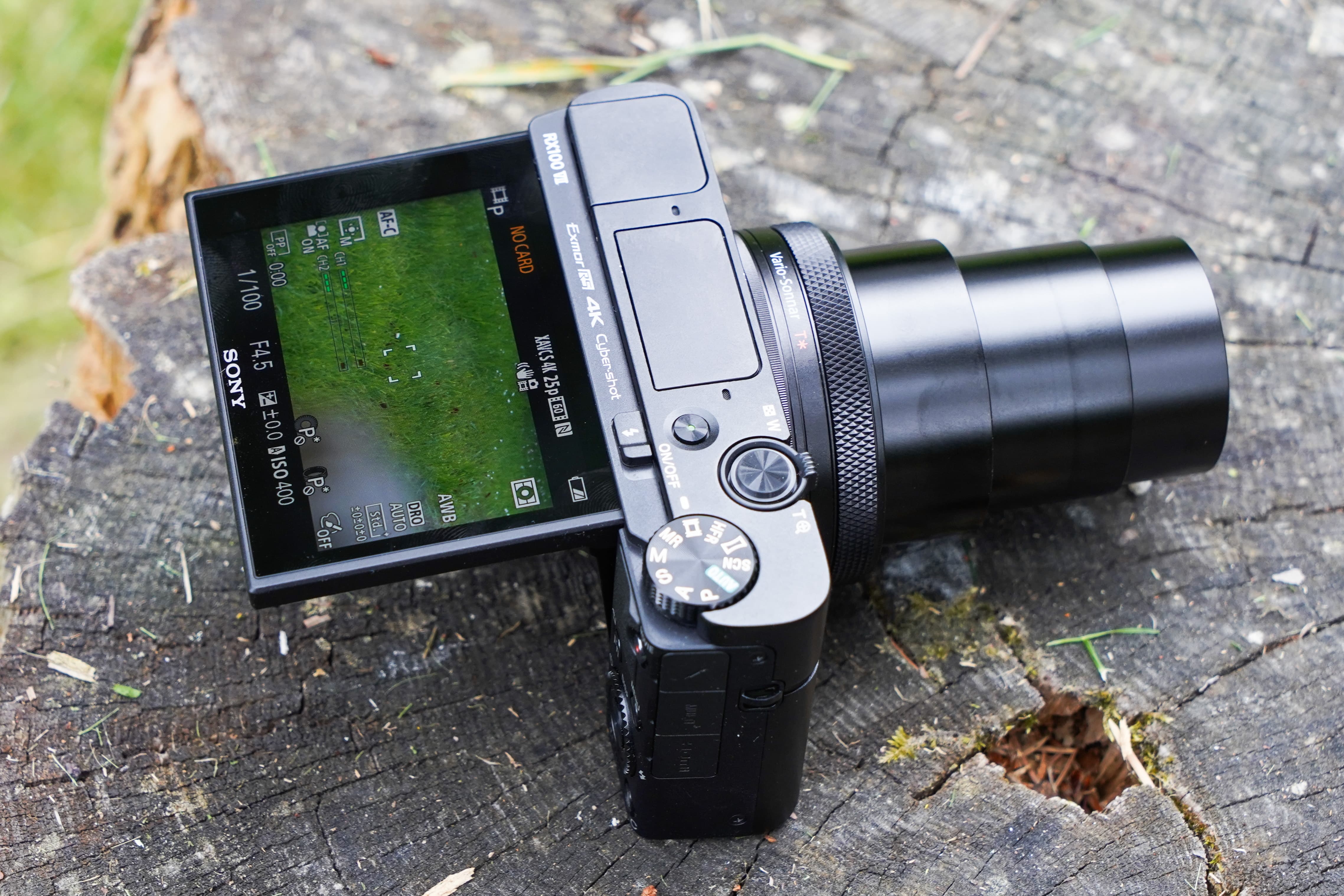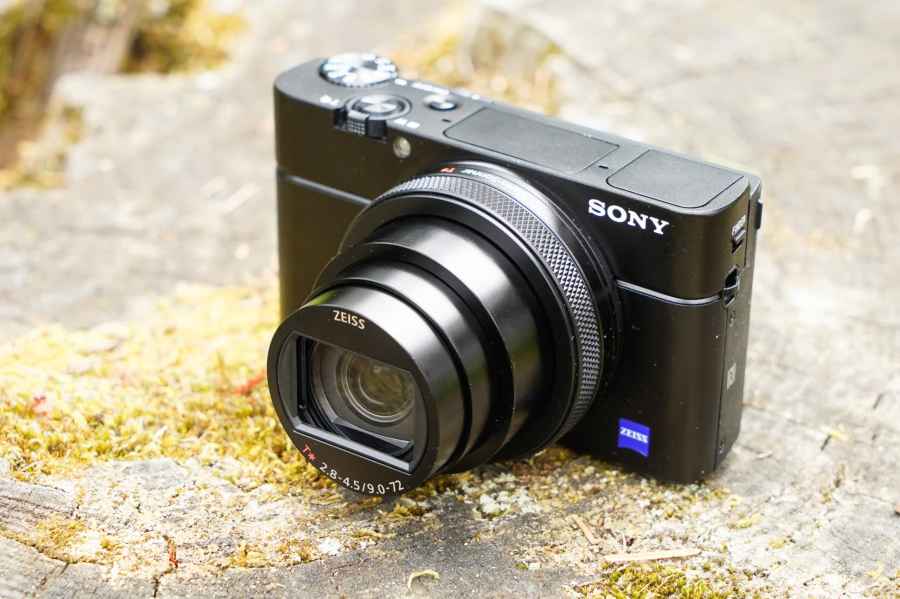Sony RX100 VII – Key Features
- 1.0-type stacked 20.1 MP Exmor RS CMOS sensor with DRAM chip and BIONZ X image processor
- 60 AF/AE tracking calculations per second and 20fps blackout-free shooting with AF/AE tracking
- 357-point focal-plane phase-detection AF + 425-point contrast-detection AF
- Real-time Tracking and Real-time Eye AF for humans and animals
- ZEISS Vario-Sonnar T* 24-200mm f/2.8-4.5 zoom lens
- Single Burst Shooting Drive Mode (90/60/30fps)
- 4K in-body movie recording with full pixel readout and no pixel binning in high bit rate XAVC S
A few days after announcing the Alpha 7R IV, Sony has released the RX100 VII into its premium compact series. Successor to the RX100 VI, the Sony RX100 VII features a newly developed 1.0-type stacked 20.1 MP Exmor RS CMOS image sensor with DRAM chip and adopts the latest Bionz image-processing engine with Front-end LSI as used in the Sony Alpha 9, Sony Alpha 7R III and new Sony Alpha 7R IV.

The Sony RX100 VII has an identical design and control layout as its predecessor, the RX100 VI
As well as 20fps blackout-free continuous shooting with AF/AE tracking, users get a new single burst shooting mode that allows up to 90fps shooting (JPEG or raw) for up to seven frames. Users also have the option to set the RX100 VII to shoot at 60fps or 30fps in this new Single Burst Shooting drive mode.
The Sony RX100 VII has the same ZEISS Vario-Sonnar T* 24-200mm f/2.8-4.5 zoom lens as its predecessor, but focuses faster (0.02sec), making it the world’s fastest AF performance among fixed-lens still cameras with a 1in sensor.

The Sony RX100 VII features a 180-degree flip screen and introduces a 3.5mm microphone input
Other highlights include a 357-point phase-detection autofocus system with 425 contrast-detection AF points, a pop-up EVF and Real-time Eye AF for humans and animals. Real-time Tracking utilises Sony’s latest algorithm including artificial intelligence-based object recognition to ensure that subjects can be captured with excellent accuracy, even via the touch panel on the rear screen. Sony’s Real-time Eye AF employs AI-based object recognition to detect and process eye data in real time, resulting in improved accuracy, speed and tracking performance of Eye AF for both humans and animals.
Image stabilisation on the Sony RX100 VII is claimed to be 8x more effective than the previous model and a 3.5mm microphone input has been added at the side for vloggers and moviemakers who’d like to record better audio. Available from August, the RX100 VII will cost £1,200 – £200 more than the Sony RX100 IV could be picked up for at the time of writing (25.07.2019) with a £100 cashback deal.
Asked if the Sony RX100 VII replaces the Sony RX100 VI outright, Sony told AP the two cameras will run alongside each other.
Sony RX100 VII – Press release
Sony today (25.07.2019) announced a new addition to its award-winning series of RX cameras with the launch of the RX100 VII (model DSC-RX100M7). Utilising technologies developed for Sony’s full-frame mirrorless camera Alpha 9, the RX100 VII achieves new levels of performance in a compact camera, in both stills and movie shooting, inspiring the user to feel confident that they are armed with professional-level power in their pocket for spontaneous shooting in everyday life.
The RX100 VII is powered by a newly developed 1.0-type stacked Exmor RS CMOS image sensor and the latest generation BIONZ X image processor. This combination delivers new levels of autofocus performance and achieves speed breakthroughs that have previously only been seen on the Alpha 9. Flexibility of shooting is ensured by a ZEISS® Vario-Sonnar T* 24-200mmviii F2.8-4.5 high magnification zoom lens, making the RX100 VII a versatile choice for all types of shooting scenarios and users, from photo enthusiasts to professionals.
New Standard for AF Performance in a Compact Camera
The RX100 VII offers a world leadingv 357 focal-plane phase-detection AF points and 425 contrast-detection AF points. In addition, thanks to a newly optimised lens drive control, world’s fastestv 0.02 secvi AF acquisition time is realised. A major leap in AF/AE tracking performance during continuous shooting[i] means the camera performs AF/AE calculations up to 60 times per secondii and captures fast moving action at 20fpsiii with AF/AE tracking, ensuring that each moment is shot with swift and accurate focus.
In addition, the image sensor realises blackout-free shootingiv for a completely live view, even when continuous shooting at 20fpsiii; the same experience as the Alpha 9. The RX100 VII also debuts a new drive mode, Single Burst Shootingix, for capturing the perfect high-speed shot at up to 90fpsx in JPEG/RAW format utilising the anti-distortion shutter. ‘Single Burst Shooting’ix allows the photographer to frame fast moving action and shoot as if taking a single shot but the camera will actually deliver 7 still images, taken at 90fps, 60fps or 30fps, so the user can select the perfect moment.
For the first time in a compact camera, the RX100 VII introduces advanced ‘Real-time Tracking’ and ‘Real-time Eye AF’ capabilities. ‘Real-time Tracking’ utilises Sony’s latest algorithm including artificial intelligence-based object recognition to ensure that subjects can be captured with excellent accuracy, even via the touch panel on the rear screen. ‘Real-time Eye AF’, the latest version of Sony’s acclaimed Eye AF technology, employs AI-based object recognition to detect and process eye data in real time, resulting in improved accuracy, speed and tracking performance of Eye AF for both humans and animalsvii, and allows the photographer to concentrate exclusively on composition[ii].
Movie-Making Marvel
The compact and lightweight characteristics of the RX100 VII (approx. 302g / 102mm x 58mm x 43mm[iii]) mean it can always be carried around and can be mounted in places that larger cameras cannot. But its small factor belies a multitude of pro-level movie-making capabilities perfect for on-the-go shooting such as vlogging:
- 4K in-body movie recording with full pixel readout and no pixel binning in high bit rate XAVC S™xi
- Real-time Tracking and Real-time Eye AF for video
- 4K Active SteadyShot that is 8x more effective than 4K Standard SteadyShot[iv]
- Integrated Microphone input[v]
- Hybrid Log-Gamma (HDR) / S-Gamut3.Cine / S-Log3, S-Gamut3/S-Log3
- Compatibility with ‘Movie Edit add-on’ from the ‘Imaging EdgeTM’ mobile application for movie stabilisation and editing
- Vertical-position data recording for movies[vi]
- Interval Shooting[vii] for stunning time-lapse videos
- Super Slow Motion[viii] recording at up to 1000fps
- 180-degree flip screen for ease-of use whilst vlogging
“The RX100 VII sets new standards for both photography and videography in a compact camera and we are confident that its phenomenal speed and AF capabilities will be very well received by customers,” said Yann Salmon Legagneur, Director of Product Marketing, Digital Imaging, Sony Europe. “Users will feel the reassurance that that they have the power of an Alpha 9 in their pocket, in compact form, so they can trust this camera in any given situation.”
Shooting Grip Kit for Vloggers
A simple vlogging setup with an external microphone is made possible with the Shooting Grip Kit (DSC-RX100M7G). The kit includes an RX100 VII, Shooting Grip (VCT-SGR1) which allows for easy recording and zooming right at your fingertips, Bracket with Accessory Shoe to attach the Microphone, and two Rechargeable Battery Packs (NP-BX1)[ix].
New Jacket Case for the RX100 Series
Sony has also introduced a new leather-look body case for the RX100 series (LCJ-RXK) which includes a lens jacket and shoulder strap to protect the camera from bumps and shocks. It provides easy access to the microphone jack and USB terminal which enables charging and image transfers without the need to remove the case. Available in Black or Beige.
Pricing and Availability
The RX100 VII and LCJ-RXK will ship in Europe in August 2019 priced at approximately €1,300 and £1,200 and €85 respectively.
[i] Compared to RX100 VI
[ii] Both right eye and left eye are selectable, either via the menu or by the touchscreen panel
[iii] Width x Height x Depth
[iv] Image compensation angle at wide-end (Comparison with 4K standard mode)
[v] Attaching a mic without the Shooting Grip Kit requires an optional accessory
[vi] In-camera movie playback is in the horizontal position. Whether or not movies are displayed in the vertical position depends on your device
[vii] Wi-Fi does not work during interval shooting
[viii] Audio recording is not available. A Class 10 or higher SDHC/SDXC memory card is required
[ix] One included with RX100 VII body







